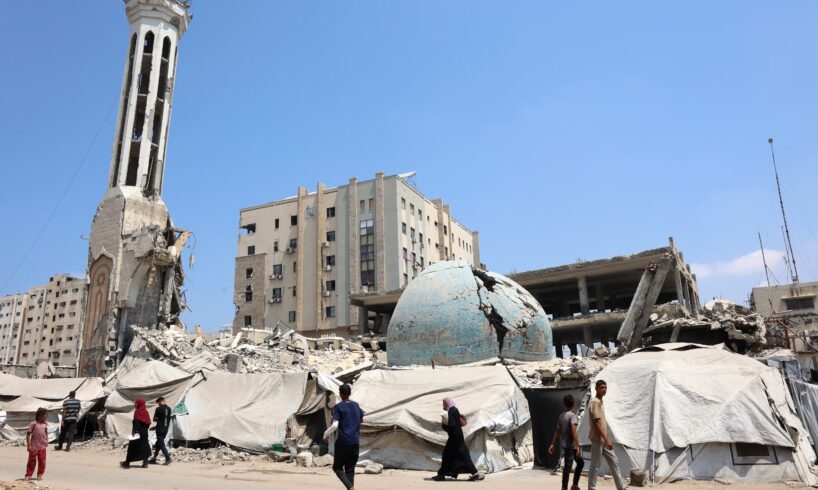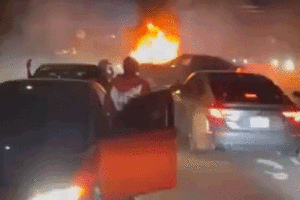
Good morning. The Blue Jays are going to the World Series. More on that below, along with the work to dig out Gaza from 60 million tonnes of rubble and the latest on the Louvre jewel heist. But first:
Today’s headlinesOpen this photo in gallery:
The destroyed Abu Khudra mosque in Gaza City in August.OMAR AL-QATTAA/AFP/Getty Images
Middle EastThe enormity of Gaza’s recovery
Gaza has been a cultural crossroads for more than 5,000 years, connecting Africa with Asia, and the desert with the Mediterranean, to serve as a major economic, strategic and intellectual hub. The Pharaohs, Babylonians, Greeks, Romans and Turks all left their marks on Gaza’s landscape and monuments. It is one of the oldest places on Earth. There is virtually nothing of it left.
“The devastation is on the scale of Hiroshima or Dresden,” Yezid Sayigh, a senior fellow at the Carnegie Middle East Center in Beirut, told The Globe. A UN report found that by February of 2024, Israel had dropped more than 25,000 tonnes of explosives on Gaza – the equivalent of two nuclear bombs in just the first five months of the war. Now, 84 per cent of what humans built there has been destroyed, including homes, universities and hospitals; in Gaza City, the damage is closer to 92 per cent. Altogether, reconstruction will cost US$70-billion and likely take decades.
And there’s no guarantee the ceasefire will hold. A new round of violence erupted over the weekend: Israel launched waves of air strikes, killing 45 people in Gaza, after it said two soldiers had been killed by Palestinian militants. Hamas was getting “quite rambunctious,” U.S. President Donald Trump said, dispatching Steve Witkoff (his special envoy) and Jared Kushner (his son-in-law) to Israel yesterday to shore up the fragile truce. Over the past week, Hamas has carried out public executions of people it calls “collaborators and outlaws.” Israel continues to put restrictions on the delivery of humanitarian aid.
The aid that does enter Gaza – flour, medicine, ready-to-eat meals – struggles to move across the narrow territory. More than 3,000 kilometres of roads have been wrecked by Israel’s military campaign. The UN says it has removed 81,000 tonnes of debris to help humanitarian agencies get supplies and support to Palestinians, but that’s a fraction of the job ahead. At least 61 million tonnes of rubble need to be cleared during the first phase of Gaza’s reconstruction, which is enough to build the Great Pyramid of Giza 10 times over.
Open this photo in gallery:
Water is scarce in Gaza.BASHAR TALEB/AFP/Getty Images
Right now, that work is being done by men using little more than pickaxes and shovels. The war destroyed roughly 95 per cent of the enclave’s heavy machinery, estimates Gaza City civil engineer Nabil Abu Muaileq, and there’s no way to bring in new equipment such as excavators and cranes. Israel maintains a long list of dual-use items, banned because they could be repurposed for military objectives. In 2022, Oxfam reported that Israel’s restrictions went far beyond international standards to include steel pipes, sewage pumps and cement mixers. By 2024, CNN found the ban extended to anesthetics, maternity kits and water purification tablets.
Gaza urgently needs clean water: UNICEF estimates 480 of the territory’s 600 water and sanitation facilities have been damaged or destroyed. It needs medical centres: According to the World Health Organization, barely a dozen hospitals are left in Gaza, all partly operational. It needs schools: The UN says 92 per cent of buildings require considerable work in order to function. About half of Gaza’s prewar population of 2.2 million were children, all of whom have gone without education for more than two years.
And Gaza desperately needs assurances that the US$70-billion reconstruction effort won’t be in vain – that neighbourhoods levelled by Israel’s strikes might have a chance to stand again. “The fundamental question haunting every planning session is not what it will cost,” Habib Badawi, a Lebanese University professor of international relations, wrote in a recent report, “but what guarantee exists that what is built today will not be destroyed tomorrow.”
The ShotThe Jays are headed to the World SeriesOpen this photo in gallery:
George Springer celebrates his three-run homer in the seventh.Frank Gunn/The Canadian Press
The Jays overcame a two-game series deficit and a two-run hole in the seventh inning last night, beating Seattle 4-3 in Game 7 of the ALCS and booking their ticket to the World Series for the first time since 1993. They’ll face Shohei Ohtani and the L.A. Dodgers on Friday at the Rogers Centre. Two down, one to go.
The WrapWhat else we’re following
At home: After accusing the RCMP of covering for former prime minister Justin Trudeau, Conservative Leader Pierre Poilievre tried to clarify his comments yesterday.
Abroad: France scrambled to beef up security at the Louvre as police searched for the thieves who snatched eight priceless crown jewels in a brazen daytime heist.
In court: About 100 protesters gathered outside an Edmonton courthouse to call for justice in the murder of 14-year-old Samuel Bird.
In transit: A rare kayak and other cultural objects in the Vatican Museums are headed back to Canada after a long repatriation campaign by Indigenous groups.
Unhappy: Downbeat businesses and consumers may nudge the Bank of Canada toward another interest rate cut next week.
Uncanny: Sora, OpenAI’s new social media app, makes it awfully hard to distinguish the real from the fake.





